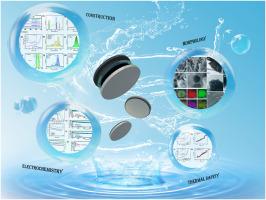Nitrogen-doped porous carbon skeleton derived from glycine boosting superior rate capability and long lifespan for Na3V2(PO4)3 with high thermal safety
IF 12.7
1区 材料科学
Q1 ENGINEERING, MULTIDISCIPLINARY
引用次数: 0
Abstract
Currently, the both low electronic and ionic conductivity have seriously hindered the further application of Na3V2(PO4)3 (NVP). Nevertheless, traditional carbon materials modification only improves the electronic conductive property, rather than modifying the ionic conductivity. Herein, N-rich carbon resources of glycine (GLY) is introduced to synthesize NVP, which can act as reducing agent and morphology inducer to optimize NVP sample. Notably, GLY supplies favorable N-doped carbon skeleton, and this defective carbon structure benefits for the accelerated electronic conductivity. Besides, porous construction is established after introducing GLY. This unique morphology significantly improves the infiltration effects of electrolyte, thus providing more electrochemical active sites for Na+ de-intercalation to improve the ionic conductivity. Meanwhile, porous framework supplies enough space for the shrinkage of crystal cells, so the stress-strain effect is highly restrained, which is demonstrated by Ex-situ XRD. The stabilized crystal and morphological structure of NVP@GLY-2 has been verified by after-cycled XRD/SEM/XPS. Highly improved kinetic characteristics are also investigated by In-situ EIS. Moreover, Accelerating Rate Calorimeter (ARC) measurements indicate that NVP@GLY-2-based half and full cells also have excellent thermal safety properties. Comprehensively, NVP@GLY-2 reveals a high capacity of 119 mAh g−1 at 0.1 C. It reveals 84.5 and 71.2 mAh g−1 at 10 and 50 C, with capacity retention rates of 88.9 % and 85.8 % after 1000 cycles.

由甘氨酸衍生的掺氮多孔碳骨架可提高 Na3V2(PO4)3 的卓越速率能力和长寿命,并具有高热安全性
目前,Na3V2(PO4)3(NVP)较低的电子导电性和离子导电性严重阻碍了其进一步应用。然而,传统的碳材料改性只能改善电子导电性能,而不能改变离子导电性。本文引入了富含 N 的甘氨酸(GLY)碳资源来合成 NVP,它可以作为还原剂和形态诱导剂来优化 NVP 样品。值得注意的是,GLY 提供了有利的掺杂 N 的碳骨架,这种有缺陷的碳结构有利于加速电子导电性。此外,引入 GLY 后,多孔结构得以形成。这种独特的形态大大提高了电解质的渗透效果,从而为 Na+ 脱闰提供了更多的电化学活性位点,从而提高了离子导电性。同时,多孔框架为晶胞的收缩提供了足够的空间,因此应力-应变效应得到了高度抑制,这一点在原位 XRD 中得到了证实。循环后 XRD/SEM/XPS 验证了 NVP@GLY-2 稳定的晶体和形态结构。原位 EIS 也研究了高度改进的动力学特性。此外,加速量热计(ARC)测量结果表明,基于 NVP@GLY-2 的半电池和全电池还具有出色的热安全特性。综合来看,NVP@GLY-2 在 0.1 摄氏度时具有 119 mAh g-1 的高容量,在 10 摄氏度和 50 摄氏度时分别为 84.5 mAh g-1 和 71.2 mAh g-1,循环 1000 次后容量保持率分别为 88.9% 和 85.8%。
本文章由计算机程序翻译,如有差异,请以英文原文为准。
求助全文
约1分钟内获得全文
求助全文
来源期刊

Composites Part B: Engineering
工程技术-材料科学:复合
CiteScore
24.40
自引率
11.50%
发文量
784
审稿时长
21 days
期刊介绍:
Composites Part B: Engineering is a journal that publishes impactful research of high quality on composite materials. This research is supported by fundamental mechanics and materials science and engineering approaches. The targeted research can cover a wide range of length scales, ranging from nano to micro and meso, and even to the full product and structure level. The journal specifically focuses on engineering applications that involve high performance composites. These applications can range from low volume and high cost to high volume and low cost composite development.
The main goal of the journal is to provide a platform for the prompt publication of original and high quality research. The emphasis is on design, development, modeling, validation, and manufacturing of engineering details and concepts. The journal welcomes both basic research papers and proposals for review articles. Authors are encouraged to address challenges across various application areas. These areas include, but are not limited to, aerospace, automotive, and other surface transportation. The journal also covers energy-related applications, with a focus on renewable energy. Other application areas include infrastructure, off-shore and maritime projects, health care technology, and recreational products.
 求助内容:
求助内容: 应助结果提醒方式:
应助结果提醒方式:


